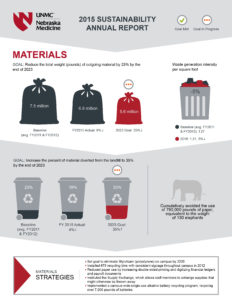Materials
Medical center campuses have a diversified waste profile consisting primarily of the following material streams: trash, regulated medical waste, hazardous waste, pharmaceutical waste and recycling. The recycling category encompasses a mix of materials, including mixed paper, plastic, tin, scrap metal, and fluorescent tubes. Over the past two decades, UNMC/NM have made great strides in the area of recycling by expanding the types of material collected and diverting over 21 million pounds of recyclable material. Despite this success, there are still many opportunities to further expand the program and to employ different waste reduction strategies that limit the amount of outgoing material that needs to be processed. If UNMC/NM employ the strategies in this section and achieve their 2023 waste reduction and recycling goals, they will dramatically reduce the amount of material routed to a landfill and potentially save up to $35,000 annually.
Baselines
The baseline values for annual disposal
and recycling diversion for UNMC/NM
represent averages calculated from data
for fiscal years 2011 and 2012. Figure 6
shows the breakdown of specific waste
types that make up the baseline.
Primary Metrics:
• Total Disposal: the total annual
weight of all outgoing materials (waste
and recycling)
• Baseline: 7.5 million pounds per year
• Recycling Diversion: percent of
total outgoing materials diverted
to recycling
• Baseline: 22.9 percent (1.8 million
pounds)
Secondary Metric:
The secondary metric is normalized for
the total size of campus facilities. This
metric can also potentially be used to
compare UNMC/NM to other health care
and university facilities.
• Waste generation intensity per
square foot
• Baseline: 1.27 pounds per square
foot (based on 5,749,502 pounds of
annual material that is not recycled
and 4,536,868 square feet, which
does not include parking garages)
Waste generation intensity per full-time
equivalent (FTE) employee and student
was also considered as a secondary
metric. However, due to lack of available
data regarding FTE employees who are
primarily located on UNMC/NM’s 42nd
& Dewey campus, this secondary metric
was not included. As this data becomes
available, UNMC/NM should consider
tracking this intensity metric. |
Goals
Total Outgoing Material
Reduce the total annual weight of
outgoing material by 25 percent by the
end of 2023
Diversion Rate
Increase the percent of outgoing materials
diverted (recycled) from the landfill to
35 percent by the end of 2023 |





